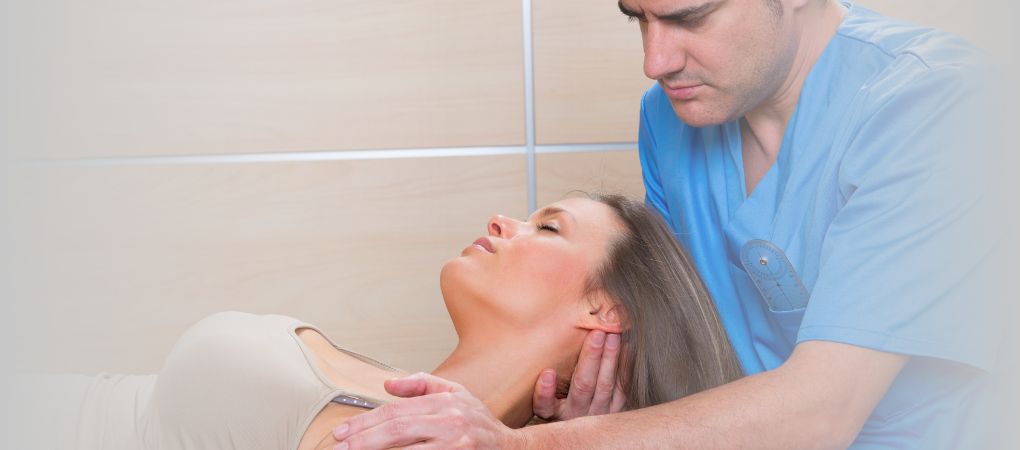Francesca Galiano
|
20/12/2023 - Last update 27/12/2023
Jayme Mancini, Zachary Oliff, Reem Abu-Sbaih, Joseph Simone, Andrea LaRosa, Sonu Mody, To Shan Li, Adena Leder | Year 2022
Abnormal Foot Progression Angle Kinematics in Cervical Dystonia Improved After Osteopathic Manipulative Medicine: A Prospective Case Series
Pathology:
Cervicalgia (cervical pain and stiff neck)
Type of study:
Prospective Case Series
Date of publication of the study’:
2022/Jun/30

Purpose of the study
- Objectives: to evaluate the effectiveness of OMT on gait biomechanical abnormalities in cases of cervical dystonia.
- Measured outcomes:
- Primary outcomes: assessment of the severity of the signs and symptoms of cervical dystonia using the Toronto Western Spasmodic Torticollis Rating Scale (TWSTRS) and their impact on quality of life using the Cervical Dystonia Impact Profile (CDIP-58), and gait angle (FPA) using motion analysis instrumentation.
Participants
- Number: 6 women (age from 25 to 67 years)
- Criteria of inclusion: ability to ambulate independently, onset of cervical dystonia symptoms before the age of 40 (not due to accident or injury.)
- The patients were recruited directly through their physicians.
- Groups of study:
- Group 1: OMT, 6 women (age from 25 to 67 years)
Interventions and evaluations
- At the beginning of the study and at the end of treatments: assessment of the severity of signs and symptoms of cervical dystonia and of their impact on quality of life through TWSTRS and CDIP-58 respectively.
- Assessment of the FPA treatments by motion analysis instrumentation at the beginning and at the end of the study.
- Five weekly OMT sessions of 30 minutes each.
- OMT: standardized treatment according to a protocol designed on previous case reports of people with cervical dystonia.
- treatment directed at resolving somatic dysfunction to improve muscle tone in relation to balance and joint alignment of feet, knees, pelvis, sacrum, spine, respiratory diaphragm, ribs, head, neck, shoulders and abdominal muscles.
- techniques used: balanced ligament tension, cranial, muscle energy, myofascial release, and Still techniques.
Results
- Primary outcomes: OMT seems to have promoted improvement in both TWSTRS and CDIP-58. In particular, the most noticeable improvement seems to have involved a decrease in pain and discomfort that affected the patients’ daily life adversely .
OMT induced a statically significant improvement in FPA by reducing from 5.13° to 0.21° the deviation from normal angulation. This evaluation was carried out only on 5 of the 6 participants. - Further analyses: the osteopathic evaluation revealed hypertonic musculature over the occipitomastoid sutures and reduced cranial rhythmic impulse in the temporal bones on the side most affected by torticollis. A state of torsional tension at the level of the sphenobasilar synchondrosis, severe restriction of movement of the C2 vertebra, sacroiliac joints, and lower extremities during pronation-supination and asymmetry in the iliac crests were found in all participants. In participants with right torticollis since birth, moderate plagiocephaly was also found.
There were no adverse effects.
Discussion
The OMT was well tolerated by the participants of this small study, who experienced improvements in their quality of life, and also obtained positive effects on their gait angle.
These findings are in line with previous case reports, as well as the results detected in the osteopathic evaluation. In fact, cervical dystonia tends to result in gait alterations and in an altered recruitment of muscles during the course of a variety of activities. In addition, cervical dystonia can affect functions, such as swallowing and vocalization, as well as visual-spatial coordination and balance. In fact, cervical dystonia tends to induce biomechanical compensations in the rest of the body, and to activate reflexes secondary to nociception or joint disorders.
Unfortunately, the results of the study are limited by the small sample size and the lack of a control group, originally planned but then removed the study. The reason being the inability of potential participants to attend the treatment sessions and the risk of social embarrassment due to the exposure of their abnormal gait without the rewarding benefits of OMT.
The review of Osteopedia
By Marco Chiera
Strengths: good introduction; description of somatic dysfunction revealed by osteopathic evaluation.
Limits: it is unclear exactly how many people were recruited, how many dropped out of the study, and why; results are only reported in the text with no chance to see the actual pre- and post-treatment values; it is not specified how adverse effects were assessed; except for one consideration in the discussions, OMT seems to be described with an “excessive” focus on the purely mechanical component alone.

Are you an osteopath?
Register and enjoy the membership benefits. Create your public profile and publish your studies. It's free!
Register now
School or training institution?
Register and enjoy the membership benefits. Create your public profile and publish your studies. It's free!
Register now
Do you want to become an osteopath? Are you a student?
Register and enjoy the membership benefits. Create your public profile and publish your studies. It's free!
Register now







